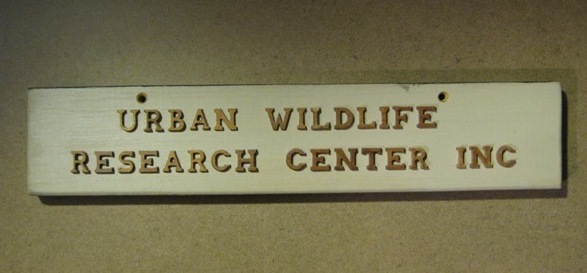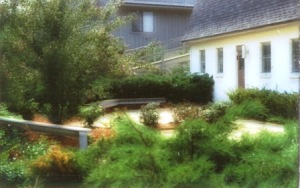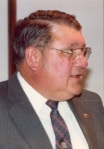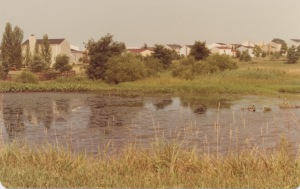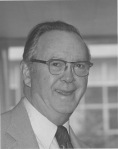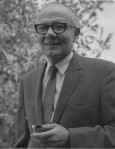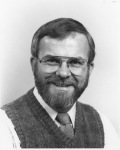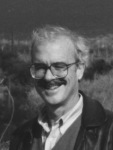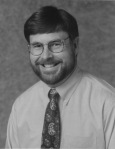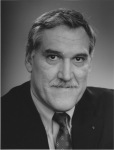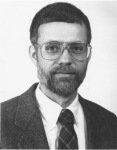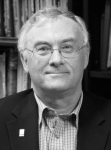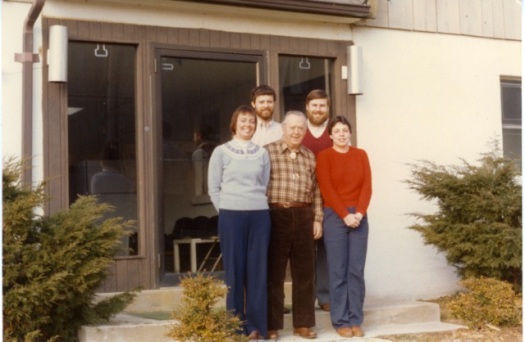
The core of the Urban Wildlife Research Center for many years. From left to right, Louise Dove, Lowell Adams, Dan Leedy, Tom Franklin, and Barbara McFalls.
History of the Urban Wildlife Research Center, Inc.
Dr. Lowell W. Adams, Retired former staff member
Center Establishment
The Urban Wildlife Research Center was incorporated in the State of Maryland on 6 November 1973. According to the organization’s by-laws, “The aims and objectives of the Corporation shall be to encourage, promote, support and conduct research and investigations that will be helpful to urban planners and managers in providing and maintaining optimal conditions for wildlife in urban and suburban areas, and to encourage more attention to urban wildlife problems in college and university wildlife training programs through support of students as research assistants on approved Urban Wildlife Research Center projects, and to study the impact of man’s works on wildlife and their habitat (UWRC:1 1973).”
The motivating force behind founding of the Center was Dr. Aelred D. Geis. In 1973, Dr. Geis was a wildlife biologist employed as an urban wildlife specialist at the Patuxent Wildlife Research Center in Laurel, Maryland, a U. S. Fish and Wildlife Service facility. Dr. Geis lived in Howard County, Maryland, and in the mid-1960s had initiated bird surveys in various habitats in the county prior to development of the New Town of Columbia. Dr. Geis believed there was a need for wildlife research in urban, suburban, and developing areas. Most wildlife biologists at the time were focused on rural and wilderness areas, and with game species. Geis realized that continued development in the rural county, located mid-way between Baltimore and Washington, D.C., was inevitable. One of his goals was, through research, to learn how to minimize the impact of development on wildlife and its supporting habitat. He convinced several local farmers and professional wildlife biologists of the need and value of a wildlife research center focused on urban areas. Local farmers agreeing with Dr. Geis and serving as early members of the Board of Directors of the Center were Alfred S. Bassler, Walter W. Beck, Frank B. Cockrell, and Dale Z. Maisel. Mr. Maisel agreed to house the Center on his property, Glenelg Manor Farm. Professional wildlife biologists and other prominent conservationists serving as early members of the Board of Directors included Fred Evenden, Vagn F. Flyger, C. R. “Pink” Gutermuth, Keith Hay, Laurence R. Jahn, Daniel L. Leedy, and Joseph P. Linduska. Early financial supporters of the Center included Dale Z. Maisel, Walter and Tad Beck, and Janet Upjohn Stearns.
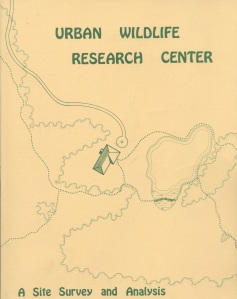 The Board of Directors hired the Nature Center Planning Division of the National Audubon Society to conduct a site survey and analysis for an urban wildlife research center located on Glenelg Manor Farm. The Division completed its work and submitted a report in December 1973 (National Audubon Society 1973). The report recognized the lack of attention given to urban areas by the wildlife profession. It also pointed out that most people live in urban areas and these people have considerable interest in wildlife through bird feeding and other activities. The site survey and analysis report identified no stable funding source for the Center. It stated that funding was anticipated to come primarily from foundation grants, contracts with various agencies and organizations, and gifts.
The Board of Directors hired the Nature Center Planning Division of the National Audubon Society to conduct a site survey and analysis for an urban wildlife research center located on Glenelg Manor Farm. The Division completed its work and submitted a report in December 1973 (National Audubon Society 1973). The report recognized the lack of attention given to urban areas by the wildlife profession. It also pointed out that most people live in urban areas and these people have considerable interest in wildlife through bird feeding and other activities. The site survey and analysis report identified no stable funding source for the Center. It stated that funding was anticipated to come primarily from foundation grants, contracts with various agencies and organizations, and gifts.
In 1973, Glenelg Manor Farm encompassed some 770 acres just west of the developing New Town of Columbia, Maryland. The concept envisioned by the Board of Directors of the Center was to allow controlled development of the property through deed covenants and restrictions. Controlled development would pertain to design, house placement, landscape plantings, lot size, density, and clustering. This would create a field laboratory for research. A plant nursery and small greenhouse were envisioned for growing plants for landscaping purposes. Thus, different types of development (e.g., large lot vs cluster housing) could be studied with regard to effects on wildlife. The effects of different landscaping practices on wildlife could be studied (e.g., native vs exotic plants). Mowing and other open space management practices could be studied, along with bird feeding practices. Peoples’ attitudes toward wildlife could be studied. Also changes in species composition and populations and wildlife-habitat relationships could be studied. It was anticipated that research also would be conducted off site in Columbia and other urban areas.
Staffing of the Center began in 1973 with the hiring of wildlife biologist Thomas M. Franklin (who served as Executive Director 1977-1982). Soon thereafter, Stephen R. Seater and Dr. Daniel L. Leedy joined the staff as Administrative Director and Research Director, respectively. Dr. Lowell W. Adams joined the Center as a wildlife biologist in 1976, followed by wildlife biologist Louise E. Dove and administrative assistant Barbara McFalls. Gomer E. Jones was appointed Executive Director of the Center in January 1983, and Thomas H. Brand, Jr. headed the organization for a short period of time before it closed in 1996.
Center Locations
After 6 years located on Folly Quarter Road, Ellicott City, Maryland, the Urban Wildlife Research Center moved its offices, in 1979, to Sheppard Lane, Ellicott City, on the outskirts of Columbia, Maryland. In 1981, it relocated to the Barn at Barnside, a 150-townhome condominium association in Columbia, Maryland. The structure was one of several farm barns retained as Columbia was developed on some 15,000 acres of former farmland. The milking parlor of the barn had been converted to a conference room, retaining much of the original fixture. Spacious offices adjoined the conference room, providing ample room for Center operations. For a short period of time before closing in 1996, the Center was located in Shepherdstown, West Virginia.
Bird Research with Patuxent Wildlife Research Center
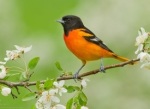 During its first 8 years of operation, the Urban Wildlife Research Center had an on-going cooperative relationship with Dr. Al Geis’s urban bird research program at Patuxent Wildlife Research Center, which focused on the effects of urbanization and open space management on birds. Under contracts with Patuxent, Center biologists conducted breeding and wintering bird surveys in various habitats in residential area, and winter bird use of established food plots. It also collaborated on artificial bird feeding experiments (Geis 1974a, b; Geis 1976; Franklin and Adams 1980; Geis 1980a, b; Geis 1981; Geis 1986a, b; DeGraaf et al. 1991).
During its first 8 years of operation, the Urban Wildlife Research Center had an on-going cooperative relationship with Dr. Al Geis’s urban bird research program at Patuxent Wildlife Research Center, which focused on the effects of urbanization and open space management on birds. Under contracts with Patuxent, Center biologists conducted breeding and wintering bird surveys in various habitats in residential area, and winter bird use of established food plots. It also collaborated on artificial bird feeding experiments (Geis 1974a, b; Geis 1976; Franklin and Adams 1980; Geis 1980a, b; Geis 1981; Geis 1986a, b; DeGraaf et al. 1991).
Annual Meeting Seminars
For six years (1977-1982) the Urban Wildlife Research Center sponsored and held a public seminar in conjunction with its annual meeting. The events were held at Howard Community College in Columbia, Maryland. In 1977, the seminar topic was “Wildlife in Urban Areas.” About 100 people attended the event, which coincided with the 10th anniversary celebration of Columbia. Dr. Al Geis discussed “The effects of the new town of Columbia on wildlife populations.” Based on his research, Dr. Geis pointed out that some birds, such as the meadowlark, declined, others, including the cardinal, persisted, and some, such as European starling, house sparrow, and mockingbird, increased with development of Columbia. Mr. Richard Myshak, Deputy Assistant Secretary of the U. S. Department of the Interior, discussed the nongame and aesthetic wildlife program of the department. He envisioned urban parks as means to educate the next generation of citizens. Dr. Fred Evenden, Executive Director of The Wildlife Society, discussed the status and significance of the nongame and urban wildlife bill pending in the U. S. Congress. Mr. Marcus Nelson, Chief, Division of National Wildlife Refuges, U. S. Fish and Wildlife Service, discussed urban refuges and refuges near large urban centers. Mr. Bernard Halla, Director, Maryland Wildlife Administration, discussed the role of the states in urban wildlife research and management. Mr. James Rouse, developer of Columbia, wrapped up the session. He stated that one of his three goals in developing Columbia was “to respect the land.” He noted that more than 350,000 trees and shrubs were planted and that major streams were protected.
“Planning for Wildlife in Cities and Suburbs” was the seminar topic in 1978. Craig Tufts of the National Wildlife Federation discussed “Backyard Wildlife Management.” Dr. John M. Anderson of the Miles Wildlife Sanctuary spoke on “Audubon Urban Wildlife Sanctuaries.” Loren Lustig, Maryland National Capital Parks and Planning Commission, wrapped up the session discussing “Values of Urban Parks for Wildlife Habitat and Environmental Education.”
The 1979 seminar was entitled “Open Space Management for Wildlife.” Vern Walker, Director of Open Space for Reston, Virginia, pointed out that residents are interested in the needs of wildlife and accept and enjoy wildlife amenities in the immediate environment. Patricia Pudelkewicz reported on her Masters research conducted in Columbia, Maryland (Pudelkewicz 1978). Pudelkewicz surveyed residents to determine visual preferences of people living near open space for various wildlife habitats. She found that combining short, woody vegetation with taller trees was most acceptable to residents. Ninety percent felt that open space was important and 71% enjoyed viewing wildlife. Dr. Al Geis of the U. S. Fish and Wildlife Service discussed urban water management for wildlife. He focused on urban stormwater management and use by wildlife of temporary sediment control ponds and permanent stormwater control impoundments. He concluded that there was need for better water management in urban areas.
Mrs. Mary Leister, a well-known local naturalist and columnist for the Baltimore Sunday Sun, was the speaker at the Urban Wildlife Research Center’s 1980 annual seminar. Mrs. Leister discussed her observations of wildlife adapting to development. She noted the requirements of food, water, and cover, and recommended that green corridors along streams and fields with diverse vegetation be maintained in cities, counties, and states.
The Center’s 1981 annual seminar featured four speakers. Mr. Philip Kopper, a free-lance writer, discussed “Glimpses of Urban Wildlife—10,000 B.C. to the Present,” an account of the evolving relationship between humans and wildlife through the ages. Mr. Kopper drew on folklore, ancient written records, art, literature, and modern science to substantiate his thesis. He pointed out that one of the weaver finches dispersed from the African savannah and took up residence in cities—the common house sparrow. In 14th Century England, kites and ravens were protected because they helped to keep the streets free of human-discarded waste. Many other examples were presented of the relationship between humans and wildlife in urban areas.
Peggy Fleming and David Manski, both of the National Park Service, discussed “Wildlife Management Problems and Possibilities in Two Parks in the Nation’s Capital.” Mr. Manski focused on the eastern gray squirrels of Lafayette Park, a small, 8-acre park across Pennsylvania Avenue from the White House. He reported that squirrel density in the park was the highest recorded in the scientific literature—20 squirrels per acre (Manski et al. 1981). The high density was due to supplemental feeding by people and many artificial nest boxes located in the park. Squirrels were causing considerable damage to the ornamental flowers and trees of the park. Manski reported that the management goal was to reduce supplemental feeding and artificial nesting structures gradually over time to support a lower density of squirrels, thus less damage to the flowers and trees.
Ms. Fleming discussed “The Meadows Program of Rock Creek Park.” She reported that a decision was made in the 1970s to reduce mowing in some sections of the 220-acre park to allow natural meadow habitat to develop. The practice enhanced wildlife habitat value of the park and was more economical to maintain.
Mr. E M Risse, a consultant in planning, wrapped up the session with a discussion of “Citizen Efforts to Improve Wildlife Habitat.” He pointed out that individual experience with the outdoor environment was important in shaping personal attitudes toward environmental issues. Mr. Risse briefly discussed the wildlife habitat value of open space provided by planned communities such as Columbia, Maryland, and Reston, Virginia, and discussed his personal experience in developing a 3-acre parcel as wildlife habitat in Columbia. He felt that a new discipline was needed to manage public and private natural areas next to residential areas.
Program topics at the 1982 seminar were “Birds of Cities Around the World,” and “Butterfly Gardening.” Dr. Donald Messersmith, Professor of Entomology and Ornithology at the University of Maryland, spoke on the first topic. Dr. Messersmith had travelled to 76 countries and all of the continents except Antarctica. Many of his trips were through his company “World Nature Tours,” which he led. Dr. Messersmith took the audience on a bird-watcher’s tour of cities throughout the world. His take home message was that, given proper habitat, birds could be seen in cities anywhere in the world. Many species are adaptable and will use formal gardens of European parks. Others can be found in the un-manicured areas of New Delhi, India, and Canberra, Australia.
 Mr. Robert Mitchell, an applied entomologist with a long career in the U. S. Fish and Wildlife Service, spoke on “Butterfly Gardening.” He was the senior author of the Golden Guide on butterflies and moths (Mitchell and Zim 1987). Mr. Mitchell noted that many butterfly species had suffered because of loss of habitat to commercial and residential development, and widespread use of pesticides. He described ways urban homeowners could assist butterflies. Nectar-producing plants are needed for adult butterflies. Food plants also are needed for the larval stage of butterflies and these often are different from plants required for adults. Mitchell stated that a wide variety of butterflies could be attracted with perennials such as blueberry, butterfly weed, sumac, sweet pepperbush, phlox, and butterfly bush, and annuals such as larkspur, petunias (not double-flowered), 4 o’clocks, marigold, and zinnia.
Mr. Robert Mitchell, an applied entomologist with a long career in the U. S. Fish and Wildlife Service, spoke on “Butterfly Gardening.” He was the senior author of the Golden Guide on butterflies and moths (Mitchell and Zim 1987). Mr. Mitchell noted that many butterfly species had suffered because of loss of habitat to commercial and residential development, and widespread use of pesticides. He described ways urban homeowners could assist butterflies. Nectar-producing plants are needed for adult butterflies. Food plants also are needed for the larval stage of butterflies and these often are different from plants required for adults. Mitchell stated that a wide variety of butterflies could be attracted with perennials such as blueberry, butterfly weed, sumac, sweet pepperbush, phlox, and butterfly bush, and annuals such as larkspur, petunias (not double-flowered), 4 o’clocks, marigold, and zinnia.
Wildlife Research and Urban Stormwater Control
In 1982 and 1983, the Urban Wildlife Research Center obtained grants from the Richard King Mellon Foundation, the Compton Foundation, the David and Lucile Packard Foundation, and the American Conservation Association to investigate wetland wildlife use of urban stormwater management structures. Two types of structures in common use at the time were studied. The detention basin was one type of facility. This structure was designed to detain stormwater from developed areas during storm events and to slowly release the water downstream. It was designed to be dry between storm events. The retention basin was the second type of facility studied. This structure was similar to the detention basin with the exception that a permanent pool of water was retained in the retention basin between storm events. Center research showed that retention basins had greater wildlife value than did detention basins, and shallow retention basins with gently sloped sides had greater value than did deep retention basins with steep side slopes. Residents living near the facilities preferred the retention basins and the wildlife associated with the structures (Adams et al. 1982; Bascietto and Adams 1983; Adams and Dove 1984; Adams et al. 1984; Adams et al. 1985a,b; Adams et al. 1986; Barnes and Adams 1998).
Urban Wildlife Open Exchanges
Beginning in 1975, in cooperation with the Urban Affairs and Regional Planning Committee (and its successor the Urban Wildlife Committee) of The Wildlife Society, the Urban Wildlife Research Center organized and held annual open exchange meetings in conjunction with the North American Wildlife and Natural Resources Conference. The meetings were designed to provide an opportunity for those interested in urban wildlife to get together and discuss programs, policies, and research and management activities.
Name Change
In February 1983, the Board of Directors passed a resolution changing the name of the Urban Wildlife Research Center to National Institute for Urban Wildlife. The thinking was that the new name more accurately reflected the geographic and program scope of the organization.
Sponsorship of Urban Wildlife Symposia
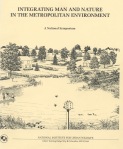 The National Institute for Urban Wildlife initiated an urban wildlife symposium series in 1986. The first symposium in the series was held in Chevy Chase, Maryland, 4-7 November. More than 250 wildlife biologists, landscape architects, urban planners, developers, city administrators, government officials, and students attended the event. They represented 32 states, the District of Columbia, Canada, England, and Japan. The opportunities and need for wildlife and nature conservation in metropolitan areas were addressed by six keynote speakers; in five technical sessions with audience discussion; in a poster paper session; and in a symposium summary. Proceedings of the symposium were published (Adams and Leedy 1987) and are available elsewhere on this website.
The National Institute for Urban Wildlife initiated an urban wildlife symposium series in 1986. The first symposium in the series was held in Chevy Chase, Maryland, 4-7 November. More than 250 wildlife biologists, landscape architects, urban planners, developers, city administrators, government officials, and students attended the event. They represented 32 states, the District of Columbia, Canada, England, and Japan. The opportunities and need for wildlife and nature conservation in metropolitan areas were addressed by six keynote speakers; in five technical sessions with audience discussion; in a poster paper session; and in a symposium summary. Proceedings of the symposium were published (Adams and Leedy 1987) and are available elsewhere on this website.
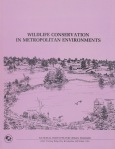 In 1990, the Institute organized another national symposium on urban wildlife, convened in Cedar Rapids, Iowa, 11-14 November. The meeting focused the attention of urban planners, landscape architects, developers, city administrators, wildlife biologists, elected officials and others on the opportunities and need for wildlife and nature conservation in metropolitan areas. Proceedings of the symposium were published (Adams and Leedy 1991) and are available elsewhere on this website.
In 1990, the Institute organized another national symposium on urban wildlife, convened in Cedar Rapids, Iowa, 11-14 November. The meeting focused the attention of urban planners, landscape architects, developers, city administrators, wildlife biologists, elected officials and others on the opportunities and need for wildlife and nature conservation in metropolitan areas. Proceedings of the symposium were published (Adams and Leedy 1991) and are available elsewhere on this website.
The third symposium in the series was held at the Seattle-Bellevue Embassy Suites Hotel, Washington, 22-26 October 1994. All three symposia provided an excellent forum for wildlife biologists and others to get together and discuss the art and science of wildlife conservation and management in metropolitan environments. After the Institute closed, the Urban Wildlife Working Group (formerly the Urban Wildlife Committee) of The Wildlife Society assumed a leadership role in continuing the series.
Publications
The Urban Wildlife Research Center (National Institute for Urban Wildlife) published a newsletter, Urban Wildlife News, throughout its 22-year history. Issues prior to 1977 were unnumbered. Volume I was initiated in 1977 and quarterly issues were published annually. Louise Dove edited most of the issues. The newsletter highlighted work of the Center and included other activities and programs related to urban wildlife nationally and internationally. For many years, current research in urban wildlife conservation was noted in the News. Summaries of the urban wildlife open exchange meetings held in conjunction with the annual North American Wildlife and Natural Resources Conference were included in the newsletter. Also included were issues of the Urban Wildlife Manager’s Notebook as they were published.
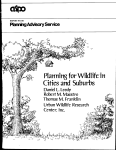 The Urban Wildlife Research Center’s first major publication on urban wildlife was Planning for Wildlife in Cities and Suburbs (Leedy et al. 1978). The manual was jointly published by the U. S. Fish and Wildlife Service and the American Society of Planning Officials. The latter organization distributed the manual to its Planning Advisory Service subscribers. It remains available through the America Planning Association as Planning Advisory Service Report No. 331.
The Urban Wildlife Research Center’s first major publication on urban wildlife was Planning for Wildlife in Cities and Suburbs (Leedy et al. 1978). The manual was jointly published by the U. S. Fish and Wildlife Service and the American Society of Planning Officials. The latter organization distributed the manual to its Planning Advisory Service subscribers. It remains available through the America Planning Association as Planning Advisory Service Report No. 331.
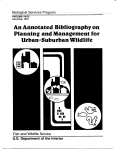 In 1979 the Center published its second major publication on urban wildlife, An Annotated Bibliography on Planning and Management for Urban-Suburban Wildlife (Leedy 1979). This document was followed with Planning for Urban Fishing and Waterfront Recreation (Leedy et al. 1981). The latter publication emphasized ways that fish and other aquatic resources could be incorporated into city plans for environmental enhancement and human enjoyment. The manual was a companion volume to Planning for Wildlife in Cities and Suburbs (Leedy et al. 1978).
In 1979 the Center published its second major publication on urban wildlife, An Annotated Bibliography on Planning and Management for Urban-Suburban Wildlife (Leedy 1979). This document was followed with Planning for Urban Fishing and Waterfront Recreation (Leedy et al. 1981). The latter publication emphasized ways that fish and other aquatic resources could be incorporated into city plans for environmental enhancement and human enjoyment. The manual was a companion volume to Planning for Wildlife in Cities and Suburbs (Leedy et al. 1978).
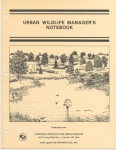 In 1983, the National Institute for Urban Wildlife initiated its Urban Wildlife Manager’s Notebook. This was a series of 18 leaflets on wildlife management techniques and approaches that could be applied to urban-suburban backyards, parks, and other open spaces. The last leaflet in the series was published in 1990. Most of the publications in the series were written by wildlife biologist Louise Dove and are available elsewhere on this website.
In 1983, the National Institute for Urban Wildlife initiated its Urban Wildlife Manager’s Notebook. This was a series of 18 leaflets on wildlife management techniques and approaches that could be applied to urban-suburban backyards, parks, and other open spaces. The last leaflet in the series was published in 1990. Most of the publications in the series were written by wildlife biologist Louise Dove and are available elsewhere on this website.
In 1984, under agreement with the U. S. Fish and Wildlife Service, and partially funded by a grant from Exxon Company, USA, the National Institute for Urban Wildlife began publishing a series of Habitat Conservation Teacher’s Pacs that were developed by the U. S. Fish and Wildlife Service. The educational materials were targeted at the fourth through seventh grade levels and consisted of “Habitat Pacs” and “Issue Pacs.” Habitat pacs in the series were Urban Areas; Freshwater Marshes; Beaches, Dunes and Barrier Islands; Rivers and Streams; and Estuaries and Tidal Marshes. Issue pacs included Wetlands Conservation and Uses, Endangered Species, Migratory Birds, Hunting and Wildlife Management, and Wildlife Conflicts. The materials were prepared in consultation with teachers and were quite popular supplemental materials for the classroom.
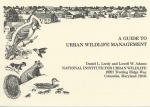 Two other publications appeared in 1984. A Guide to Urban Wildlife Management (Leedy and Adams 1984) was designed to provide interested citizens, including individual homeowners, youths and community leaders with guidance and ideas on how to plan and manage for urban and suburban wildlife. In addition to serving as a primer for urban wildlife management, it suggested how to enhance recreational, aesthetic, educational and economic benefits associated with good diversified habitats. Urban Wetlands for Stormwater Control and Wildlife Enhancement (Adams and Dove 1984) was a
Two other publications appeared in 1984. A Guide to Urban Wildlife Management (Leedy and Adams 1984) was designed to provide interested citizens, including individual homeowners, youths and community leaders with guidance and ideas on how to plan and manage for urban and suburban wildlife. In addition to serving as a primer for urban wildlife management, it suggested how to enhance recreational, aesthetic, educational and economic benefits associated with good diversified habitats. Urban Wetlands for Stormwater Control and Wildlife Enhancement (Adams and Dove 1984) was a 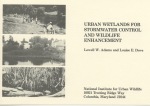 guide designed to help inform engineers, planners and developers, landscape architects, biologists, government officials and the public of the potential for designing and constructing man-made wetlands for stormwater control and wildlife enhancement.
guide designed to help inform engineers, planners and developers, landscape architects, biologists, government officials and the public of the potential for designing and constructing man-made wetlands for stormwater control and wildlife enhancement.
 In 1989, the National Institute for Urban Wildlife published Wildlife Reserves and Corridors in the Urban Environment: A Guide to Ecological Landscape Planning and Resource Conservation (Adams and Dove 1989). That document reviewed the knowledge base regarding wildlife habitat reserves and corridors in urban and urbanizing areas, and provided guidelines and approaches to ecological landscape planning and wildlife conservation for multiple environmental and societal benefits.
In 1989, the National Institute for Urban Wildlife published Wildlife Reserves and Corridors in the Urban Environment: A Guide to Ecological Landscape Planning and Resource Conservation (Adams and Dove 1989). That document reviewed the knowledge base regarding wildlife habitat reserves and corridors in urban and urbanizing areas, and provided guidelines and approaches to ecological landscape planning and wildlife conservation for multiple environmental and societal benefits.
Many of the publications mentioned above are available as downloadable documents elsewhere on this website.
Urban Wildlife Sanctuary Program
The National Institute for Urban Wildlife established its urban wildlife sanctuary program in 1986. The purpose of the program was to enhance urban wildlife habitat, promote an appreciation for, and understanding of, urban wildlife and its habitat needs, and to recognize public and private landowners who dedicated their properties to wildlife conservation. The program was directed toward individual property owners, neighborhood associations, community organizations, cities and towns, corporate owners, and developers. After the Institute closed, the Sanctuary Program was transferred to The Humane Society of the United States.
The Daniel L. Leedy Urban Wildlife Conservation Award
The Daniel L. Leedy Urban Wildlife Conservation Award was established in 1985 as the highest honor bestowed by the National Institute for Urban Wildlife. It recognized an individual for outstanding professional commitment and contributions to the conservation of wildlife and habitat in urban, suburban, and developing areas and could not be presented to more that one person a year. It was awarded from 1985 – 1993 with the exception of 1990. Recipients of the award were: Daniel L. Leedy, National Institute for Urban Wildlife, 1985; John E. Wylie, Missouri Department of Conservation, 1986; Larry W. VanDruff, State University of New York, Syracuse, 1987; William W. Shaw, University of Arizona, 1988; Thomas M. Franklin, The Wildlife Society, 1989; Richard M. DeGraaf, U. S. Forest Service, 1991; Lowell W. Adams, National Institute for Urban Wildlife, 1992; and Daniel J. Decker, Cornell University, 1993.
Awards Received
The Urban Wildlife Research Center received a Gulf Oil Conservation Award in 1982 for exceptional service in the cause of wildlife and habitat in cities, suburbs, and developing areas. The award, established by American Motors in 1953, honored individuals and non-profit organizations dedicated to conserving natural resources. The Center was one of four organizations recognized in 1982. In announcing the awards, James E. Lee, then Gulf Oil Chairman, said, “These organizations demonstrate the positive impact people with shared interests in conservation can have in making our world a better place to live.”
In May 1983, the Natural Resources Council of America presented the National Institute for Urban Wildlife with its “Award of Achievement for the Outstanding Environmental Education Project.” The publications program of the Institute was singled out for recognition, particularly the Institute’s newsletter Urban Wildlife News, and Planning for Wildlife in Cities and Suburbs, Planning for Urban Fishing and Waterfront Recreation, and An Annotated Bibliography on Planning and Management for Urban-Suburban Wildlife.
The Institute received a Certificate of Merit at the Second Annual “Take Pride in America” National Awards Ceremony on the White House lawn, 26 July 1988. The award was in recognition of the Institute’s Urban Wildlife Sanctuary Program.
Other Urban Work
Two small projects were completed in 1977. Under a contract, Urban Wildlife Research Center biologists “birdscaped” a communal garden in Columbia, Maryland. The research objective was to evaluate various shrubs for wildlife use and screening purposes in urban open spaces. The Center also prepared a management plan for a Potomac, Maryland, landowner who owned 13 acres surrounded by urbanization.
In 1978, the Center worked with a local townhouse association to “birdscape” its community, initiated an internship program with the University of Maryland, and participated in a meeting of the Committee on Urban/Nongame Wildlife Opportunities sponsored by the Northeast Section of The Wildlife Society, 5-6 October, in Stone Harbor, New Jersey.
The Institute participated in an Urban Biologists Exchange held 12-13 September 1985, in Jefferson City, Missouri. Eighteen practicing biologists convened to discuss their various programs and the future direction of those programs. Most participants were urban biologists from the Midwest employed by state conservation agencies, although the States of Washington and Florida also were represented. George Barker, Urban Coordinator, Nature Conservancy Council, England Headquarters, participated and presented an overview of European urban programs. He pointed out that incorporation of urban wildlife and nature conservation values in the planning process was becoming more prevalent and concerned groups in England were having some success in arguing that urban wildlife/nature conservation was a social need and should be so recognized by governmental bodies.
By invitation, the Institute participated in three international urban ecology meetings in England and The Netherlands in September 1987. Some 30 invited attendees, from seven countries, assembled for a 2-day seminar at Imperial College London, England, 24-25 September. The purpose of the meeting was to review the current state of knowledge and to examine the extent to which current knowledge and experience was being applied in the planning and management of towns and cities. By unanimous agreement, participants in the seminar authorized the publication of the following statement: “The International Seminar on Urban Ecology meeting in London on 24-25 September 1987 finds that there is much value in exchange of knowledge, ideas and experiences between those conducting research and experiments in urban ecology in different parts of the world, and concludes that it is highly desirable for further such seminars to be organized at fairly frequent intervals, in order to assist in advancing and integrating this important sector of ecology.” Following the 2-day seminar, a 1-day open symposium on “Nature in Cities” was held at University College London where many of the speakers at the seminar gave presentations to a wider audience. Over 100 people attended the 1-day symposium.
The experiences gained in a number of countries in improving the quality of urban life by means of ecologically-based planning, organization, and management was the subject of an international symposium on “The Role of Nature in Revitalizing Cities,” held in Delft, The Netherlands, on 29 September 1987. Experts from Japan, the United States, and several European countries spoke of their insight, experience, and ideas of urban ecological research, vegetation management, and policy, and of urban redevelopment forms integrating nature. About 100 attendees from 11 countries participated in the symposium.
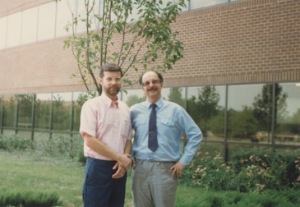
Dr. Dmitri Kavtaradze (right) with Urban Wildlife Research Center biologist Lowell Adams, August 1988.
Dr. Dmitri Kavtaradze, Head of the Laboratory of Ecology and Nature Protection, Moscow State University, USSR, and Soviet coordinator of the bilateral Soviet-American agreement on environmental education, was the Institute’s guest on 18 August 1988. Activities included a visit to The Wildlife Society headquarters in Bethesda, Maryland, and a field trip to the planned city of Columbia, Maryland. Dr. Kavtaradze’s primary interests in urban ecology centered on “Ecopolis,” a Soviet experiment in promoting public awareness of nature in cities. He defined Ecopolis as a town and its immediate surroundings where humans and animate nature mutually sustain the life of each other. Much of his work centered on the Town of Pushchino, where the Ecopolis Program started on the suggestion of local authorities and with constant participation of town residents. One of the main social goals of the Ecopolis Program was to foster ecology-conscious attitudes in the minds of residents.
In 1989, with the leadership of board member Tracy Kay, the Institute organized the Association of Nature Center Administrators as the focal point of its Nature Center Services Program. The Association was formed on the recommendation of an overwhelming majority of respondents to a nationwide market survey of more than 800 nature center administrators. The goals of the Association were to establish a national network for nature center administrators, to promote the identity and credibility of nature centers as educational facilities, and to provide nature center administrators with products and services that would improve their performance on the job. The Association incorporated in Ohio in 1993 as an independent membership organization, and in 1995 obtained its 501(c)3 status.
The National Institute for Urban Wildlife and the National Park Service’s Center for Urban Ecology organized and convened a session titled “Ecology and Wildlife Management of Urban Habitats” at the March 1993 North American Wildlife and Natural Resources Conference. The session focused on biology and ecology in an effort to help provide answers to some of the questions about wildlife and habitat in urban and urbanizing areas posed by planners, landscape architects, and others desiring to minimize impact of development on wildlife, or to enhance habitat in already developed areas. Papers in the session were published in the conference transactions.
Other Work
Highways
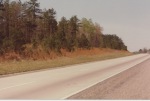 In addition to its focus on urban wildlife, the Urban Wildlife Research Center conducted field and literature studies of a broader nature. With support from the Federal Highway Administration, it published a state-of-the-art report and an annotated bibliography on highway-wildlife relationships in 1975 (Leedy 1975, Leedy et al. 1975). A multi-year field study also was conducted with support of the Federal Highway Administration (Adams and Geis 1978, Adams and Geis 1981a). Several other publications resulted from the field study (Adams 1981, 1984; Adams and Geis 1981b, 1983, 1984). A concluding manual for the Federal Highway Administration focused on wildlife considerations in planning and managing highway corridors (Leedy and Adams 1982).
In addition to its focus on urban wildlife, the Urban Wildlife Research Center conducted field and literature studies of a broader nature. With support from the Federal Highway Administration, it published a state-of-the-art report and an annotated bibliography on highway-wildlife relationships in 1975 (Leedy 1975, Leedy et al. 1975). A multi-year field study also was conducted with support of the Federal Highway Administration (Adams and Geis 1978, Adams and Geis 1981a). Several other publications resulted from the field study (Adams 1981, 1984; Adams and Geis 1981b, 1983, 1984). A concluding manual for the Federal Highway Administration focused on wildlife considerations in planning and managing highway corridors (Leedy and Adams 1982).
Surface-mined Lands
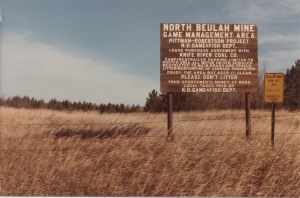 Three reports were prepared for the U. S. Department of the Interior that focused on wildlife conservation and coal surface mining. Two of the reports were prepared for the U. S. Fish and Wildlife Service and dealt with surface mine reclamation and fish and wildlife relationships in the eastern United States (Leedy 1981, Leedy and Franklin 1981). The third report was prepared for the Office of Surface Mining and covered the entire United States (Leedy et al. 1987).
Three reports were prepared for the U. S. Department of the Interior that focused on wildlife conservation and coal surface mining. Two of the reports were prepared for the U. S. Fish and Wildlife Service and dealt with surface mine reclamation and fish and wildlife relationships in the eastern United States (Leedy 1981, Leedy and Franklin 1981). The third report was prepared for the Office of Surface Mining and covered the entire United States (Leedy et al. 1987).
Gas and Oil Company Lands
In 1985, the Institute published a report on environmental conservation and the petroleum industry (Leedy et al. 1985). The report was based primarily on information obtained from the major oil and gas companies in response to a questionnaire. It did not delve deeply into the complex problems of pollution and pollution control or the intricate interactions of ecosystems. It did, however, document a wide variety of environmental influences and described approaches the industry had taken to make its operations compatible with the environment. Examples of fish and wildlife use of petroleum industry-owned or –leased lands and waters, and of pipelines, offshore oil and gas platforms, and other facilities were given.
Electric Utility Lands
In 1980, the Urban Wildlife Research Center published a report for the Edison Electric Institute (Leedy 1980). The report was based on a survey of the industry and focused on compatibility of fish, wildlife, and floral resources with electric power facilities and lands.
Consulting
In early 1977, the Board of Directors of the Urban Wildlife Research Center dealt with a policy issue regarding work of the Center. The issue was whether the Center should focus on research or consulting. Dr. Al Geis, who initiated establishment of the Center but was not a board member, stressed that consulting was not the Center’s primary goal as envisioned by its creators. Other board members pointed out that consulting could be a source of income for the Center and that money from consulting could support the research effort. The board subscribed to the latter argument and decided that the Center should pursue consulting work as part of its mission. Later that year, the Center teamed with Miller, Wihry & Lee, Inc., a Washington, D.C. consulting firm, and prepared a chapter on fish and wildlife management for the U. S. Army Corps of Engineers’ land management manual. The Center also helped the firm prepare master plans for Muscatatuck National Wildlife Refuge in Indiana and Ottawa National Wildlife Refuge in Ohio.
In 1978, the Urban Wildlife Research Center worked with Miller, Wihry & Lee and the Center for Natural Areas to prepare a natural resources management plan for Aberdeen Proving Ground (U. S. Army). The Center focused on fish and wildlife management aspects of the plan.
In 1980, the Center again teamed with Miller, Wihry & Lee to develop a management plan for the Middle Patuxent Environmental Area of Howard County, Maryland. The 1,021-acre area was originally slated for housing development as part of the New Town of Columbia. Because of reasoned and sustained arguments from local residents regarding the valuable natural qualities of the area, however, the developer agreed to forego housing development in exchange for slightly increased housing density elsewhere in Columbia. The recommended plan called for purchase of the site by Howard County and management by Howard County’s Department of Recreation and Parks. The developer agreed to sell the area to the County and to place funds from the sale in trust with the newly formed Middle Patuxent Environmental Foundation to help manage the area. The sale and trust were subsequently consummated and Howard County’s Department of Recreation and Parks assumed management responsibilities for the area in a cooperative partnership with the Foundation.
Over the years, the Urban Wildlife Research Center engaged in other consulting projects, but consulting activity never became a major focus of its operations.
Final Remarks
The biologists and farmers who established the Urban Wildlife Research Center in 1973 were visionaries. Their goal of establishing a center to study the effects of urbanization on wildlife and how to minimize the impact of development on wildlife and its supporting habitat was commendable, I think. Had controlled development of Glenelg Manor Farm through deed covenants and restrictions been allowed to proceed, the Center would have had an excellent field laboratory to study the effects of house placement, lot size, density, house clustering, and landscape plantings on wildlife and wildlife habitat. In hindsight, two big obstacles kept the Center from fully realizing its early vision. One was lack of a stable funding source. The second obstacle was that county zoning changes could not be obtained in the 1970s to allow the type of development envisioned. The concept of clustering was new in the early 1970s and county officials were somewhat skeptical of the plan. The Howard County Council had recently altered county zoning to allow for development of Columbia under “New Town” zoning, and was reluctant to make further changes in zoning. Although its original vision was not realized, I think the Urban Wildlife Research Center (National Institute for Urban Wildlife) produced a good body of work for others to build on.
Lowell Adams
Columbia, Maryland
January 2015
Suggested citation:
Adams, L. W. 2015. History of the Urban Wildlife Research Center, Inc. <https://uwrc2.wordpress.com>.
Literature Cited
Adams, L. W. 1981. Effects of roads on small mammals. Transactions of the Northeast Section of The Wildlife Society 38:152-153.
Adams, L.W. 1984. Small mammal use of an interstate highway median strip. Journal of Applied Ecology 21:175-178.
Adams, L. W., and L. E. Dove. 1984. Urban wetlands for stormwater control and wildlife enhancement. National Institute for Urban Wildlife, Columbia, Md.
Adams, L. W., and L. E. Dove. l989. Wildlife reserves and corridors in the urban environment: a guide to ecological landscape planning and resource conservation. ISBN 0-942015-02-9, National Institute for Urban Wildlife, Columbia, Md.
Adams, L. W., and A. D. Geis. 1978. Effects of highways on wildlife populations and habitats: selection and evaluation of procedures. Report No. FHWA-RD-78-92, Federal Highway Administration, U. S. Department of Transportation, Washington, D.C.
Adams, L. W., and A. D. Geis. 1981a. Effects of highways on wildlife. Report No. FHWA-RD-81-067, Federal Highway Administration, U. S. Department of Transportation, Washington, D.C.
Adams, L. W., and A. D. Geis. 1981b. Roads and roadside habitat in relation to small mammal distribution and abundance. Pages 54-1 to 54-7 in R. E. Tillman, ed. Environmental concerns in rights-of-way management: proceedings of second symposium. Report No. WS-78-141, Electric Power Research Institute, Box 50490, Palo Alto, Cal.
Adams, L. W., and A. D. Geis. 1983. Effects of roads on small mammals. Journal of Applied Ecology 20:403-415.
Adams, L. W., and A. D. Geis. 1984. Effects of roads on breeding birds. Pages 562-569 in A. F. Crabtree, ed. Proceedings of the third international symposium on environmental concerns in rights-of-way management. Mississippi State University, Mississippi State.
Adams, L. W., and D. L. Leedy, eds. l987. Integrating man and nature in the metropolitan environment. ISBN 0-942015-00-2, National Institute for Urban Wildlife, Columbia, Md.
Adams, L. W., and D. L. Leedy, eds. 1991. Wildlife conservation in metropolitan environments. ISBN 0-942015-03-7, National Institute for Urban Wildlife, Columbia, Md.
Adams, L. W., L. E. Dove, and T. M. Franklin. 1985a. Mallard pair and brood use of urban stormwater-control impoundments. Wildlife Society Bulletin 13:46-51.
Adams, L. W., L. E. Dove, and T. M. Franklin. 1985b. Use of urban stormwater control impoundments by wetland birds. Wilson Bulletin 97:120-122.
Adams, L. W., L. E. Dove, and D. L. Leedy. 1984. Public attitudes toward urban wetlands for stormwater control and wildlife enhancement. Wildlife Society Bulletin 12:299-303.
Adams, L. W., D. L. Leedy, and T. M. Franklin. 1982. Wildlife enhancement in urban stormwater control. Pages 384-391 in W. DeGroot, ed. Stormwater detention facilities. American Society of Civil Engineers, New York, N.Y.
Adams, L. W., T. M. Franklin, L. E. Dove, and J. M. Duffield. 1986. Design considerations for wildlife in urban stormwater management. Transactions of the North American Wildlife and Natural Resources Conference 51:249-259.
Barnes, T. G., and L. Adams. 1998. Creating urban stormwater control ponds for water quality and wildlife habitat. Cooperative Extension Service Publication FOR-73, University of Kentucky, Lexington.
Bascietto, J. J., and L. W. Adams. 1983. Frogs and toads of stormwater management basins in Columbia, Maryland. Bulletin of the Maryland Herpetological Society 19:58-60.
DeGraaf, R. M., A. D. Geis, and P. A. Healy. 1991. Bird population and habitat surveys in urban areas. Landscape and Urban Planning 21:181-188.
Franklin, T. M., and L. W. Adams. 1980. Bird response to habitat improvement in an urban environment. Maryland Birdlife 36:14-16.
Geis, A. D. 1974a. Effects of urbanization and type of urban development on bird populations. Pages 97-105 in J. H. Noyes and D. R. Progulske, editors. A symposium on wildlife in an urbanizing environment. University of Massachusetts, Cooperative Extension Service, Amherst.
Geis, A. D. 1974b. The new town bird quadrille. Natural History 83:54-60.
Geis, A. D. 1976. Bird populations in a new town. Atlantic Naturalist 31:141-146.
Geis, A. D. 1980a. Breeding and wintering bird populations at Cylburn Park and vicinity before the construction of Coldspring Town. Pages 5-8 in James F. Lynch, editor. Bird populations–A litmus test of the environment. Proceedings of the Mid-Atlantic natural history symposium. Atlantic Naturalist 33.
Geis, A. D. 1980b. Relative attractiveness of different foods at wild bird feeders. U. S. Fish and Wildlife Service, Special Scientific Report–Wildlife No. 233.
Geis, A. D. 1981. Management and research opportunities with urban wildlife. Pages 37-40 in Ron R. Odom and J. W. Guthrie, editors. Proceedings of the nongame and endangered wildlife symposium, August 13-14, 1981, Athens, Georgia. Technical Bulletin WL5. Georgia Department of Natural Resources, Game and Fish Division, Atlanta.
Geis, A. D. 1986a. Planning and design for wildlife conservation in new residential developments–Columbia, Maryland. Pages 67-70 in K. Stenberg and W. W. Shaw, editors. Wildlife conservation and new residential developments: Proceedings of a national symposium on urban wildlife. University of Arizona, School of Renewable Natural Resources, Tucson.
Geis, A. D. 1986b. Wildlife habitat considerations in Columbia, Maryland and vicinity. Pages 97-99 in K. Stenberg and W. W. Shaw, editors. Wildlife conservation and new residential developments: Proceedings of a national symposium on urban wildlife. University of Arizona, School of Renewable Natural Resources, Tucson.
Leedy, D. L. 1975. Highway-wildlife relationships. Vol. 1. A state-of-the-art report. Report No. FHWA-RD-76-4, Federal Highway Administration, U. S. Department of Transportation, Washington, D.C.
Leedy, D. L. l979. An annotated bibliography on planning and management for urban-suburban wildlife. FWS/OBS-79/25. U. S. Fish and Wildlife Service, Washington, D.C.
Leedy, D. L. 1980. Compatibility of fish, wildlife, and floral resources with electric power facilities and lands: an industry survey analysis. Edison Electric Institute, Washington, D.C.
Leedy, D. L. 1981. Coal surface mining reclamation and fish and wildlife relationships in the eastern United States. Vol. I, Past findings, the surface Mining Law of 1977 (P.L. 95-87), future planning and management considerations, and information sources. Report No. FWS/OBS-80/24. U. S. Fish and Wildlife Service, Washington, D.C.
Leedy, D. L., and L. W. Adams. 1982. Wildlife considerations in planning and managing highway corridors. Report No. FHWA-TS-82-212, Federal Highway Administration, U.S. Department of Transportation, Washington, D.C.
Leedy, D. L., and L. W. Adams. 1984. A guide to urban wildlife management. National Institute for Urban Wildlife, Columbia, Md.
Leedy, D. L., and T. M. Franklin. 1981. Coal surface mining reclamation and fish and wildlife relationships in the eastern United States. Vol. II, Opportunities and approaches for fish and wildlife planning and management in coal surface mining, reclamation and postmining land use. Report No. FWS/OBS-80/25. U. S. Fish and Wildlife Service, Washington, D.C.
Leedy, D. L., L. W. Adams, and L. E. Dove. 1985. Environmental conservation and the petroleum industry. American Petroleum Institute, Washington, D.C.
Leedy, D. L., T. M. Franklin, and E. G. Hekimian. 1975. Highway wildlife relationships. Vol. 2. An annotated bibliography. Report No. FHWA-RD-76-5, Federal Highway Administration, U.S. Dep. of Transportation, Washington, D.C.
Leedy, D. L., T. M. Franklin, and R. M. Maestro. l98l. Planning for urban fishing and waterfront recreation. FWS/OBS-80/35. U.S. Fish and Wildlife Service, Washington, D.C.
Leedy, D. L., R. M. Maestro, and T. M. Franklin. l978. Planning for wildlife in cities and suburbs. FWS/OBS-77/66, U.S. Fish and Wildlife Service, Washington, D.C., and American Society of Planning Officials, Chicago, Ill.
Leedy, D. L., L. W. Adams, G. E. Jones, and L. E. Dove. 1987. Environmental conservation and the coal surface mining industry. National Institute for Urban Wildlife, Columbia, Maryland.
Manski, D. A., L. W. VanDruff, and V. Flyger. 1981. Activities of gray squirrels and people in a downtown Washington, D.C. park: management implications. Transactions of the North American Wildlife and Natural Resources Conference 46:439-454.
Mitchell, R. T., and H. S. Zim. 1987. Butterflies and moths: a guide to the more common American species. Golden Press, New York, New York.
National Audubon Society. 1973. Urban Wildlife Research Center: a site survey and analysis. Report 6-74-184/108, National Audubon Society, New York, N.Y.
Pudelkewicz, P. A. 1978. Visual response to urban wildlife habitat. Thesis, Humboldt State University, Arcata, California, USA.
UWRC. 1973. By-laws of the Urban Wildlife Research Center (Incorporated in the State of Maryland 11/6/73).
